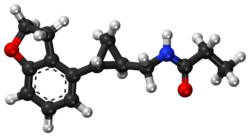Tasimelteon
 |
|
 |
|
| Clinical data | |
|---|---|
| Trade names | Hetlioz |
| Pregnancy category |
|
| Routes of administration |
Oral |
| ATC code | N05CH03 (WHO) |
| Legal status | |
| Legal status |
|
| Pharmacokinetic data | |
| Bioavailability | not determined in humans |
| Protein binding | 89–90% |
| Metabolism | extensive hepatic, primarily CYP1A2 and CYP3A4-mediated |
| Biological half-life | 0.9–1.7 h / 0.8–5.9 h (terminal) |
| Excretion | 80% in urine, 4% in feces |
| Identifiers | |
|
|
| CAS Number |
609799-22-6 |
| PubChem (CID) | 10220503 |
| IUPHAR/BPS | 7393 |
| ChemSpider |
8395995 |
| UNII |
SHS4PU80D9 |
| ChEBI |
CHEBI:79042 |
| ECHA InfoCard | 100.114.889 |
| Chemical and physical data | |
| Formula | C15H19NO2 |
| Molar mass | 245.32 g/mol |
| 3D model (Jmol) | Interactive image |
|
|
|
|
|
|
|
Tasimelteon (trade name Hetlioz) is a drug approved by the U.S. Food and Drug Administration (FDA) in January 2014 for the treatment of non-24-hour sleep–wake disorder (also called Non-24, N24 and N24HSWD). In June 2014, the European Medicines Agency accepted an EU filing application for tasimelteon and in July 2015, the drug was approved in Europe for the treatment of non-24-hour sleep-wake rhythm disorder in totally blind adults, but not in the rarer case of non-24 in sighted people.
Tasimelteon is a selective agonist for the melatonin receptors MT1 and MT2, similar to other members of the melatonin receptor agonist class of which ramelteon (2005) and agomelatine (2009) were the first approved. As a treatment for N24HSWD, as with melatonin or other melatonin derivatives, the patient may experience improved sleep timing while taking the drug. Reversion to baseline sleep performance occurs within a month of discontinuation.
Tasimelteon (previously known as BMS-214,778) was developed for the treatment of insomnia and other sleep disorders. A phase II trial on circadian rhythm sleep disorders was concluded in March 2005. A phase III insomnia trial was conducted in 2006. A second phase III trial on insomnia, this time concerning primary insomnia, was completed in June 2008. In 2010, the FDA granted orphan drug status to tasimelteon, then regarded as an investigational medication, for use in totally blind adults with N24HSWD. (Through mechanisms such as easing the approval process and extending exclusivity periods, orphan drug status encourages development of drugs for rare conditions that otherwise might lack sufficient commercial incentive.)
On completion of Phase III trials, interpretations of the clinical trials by the research team concluded that the drug may have therapeutic potential for transient insomnia in circadian rhythm sleep disorders. A year-long (2011–2012) study at Harvard tested the use of tasimelteon in blind subjects with non-24-hour sleep-wake disorder. The drug has not been tested in children nor in any non-blind people.
...
Wikipedia
